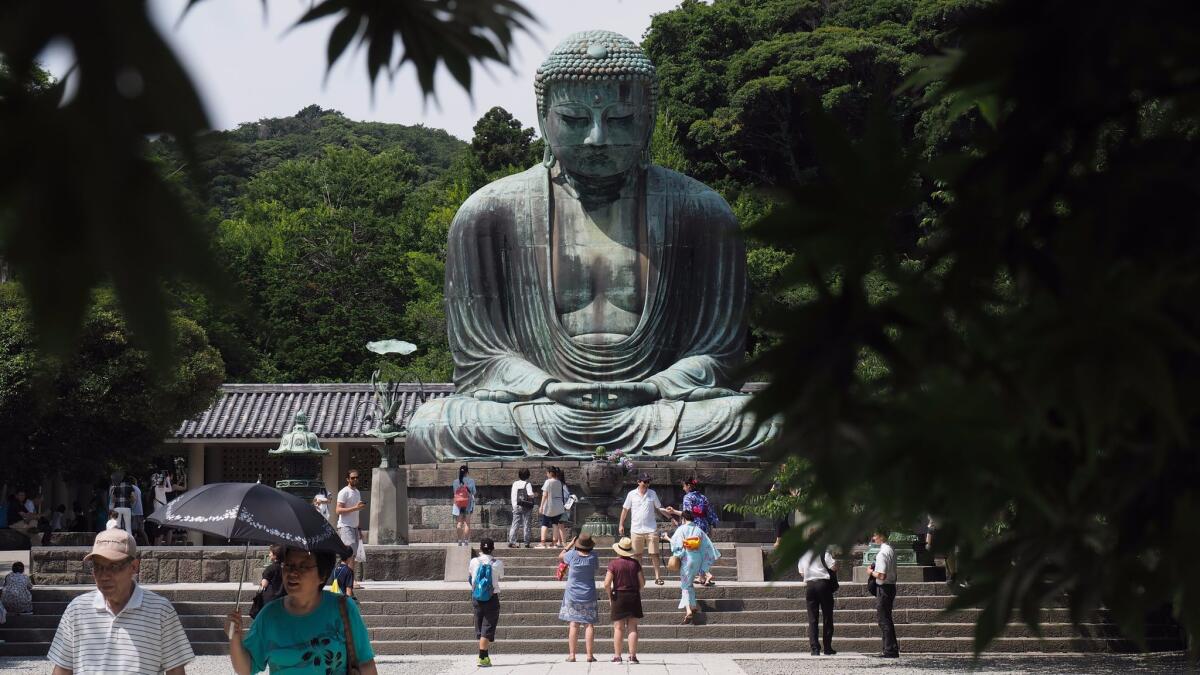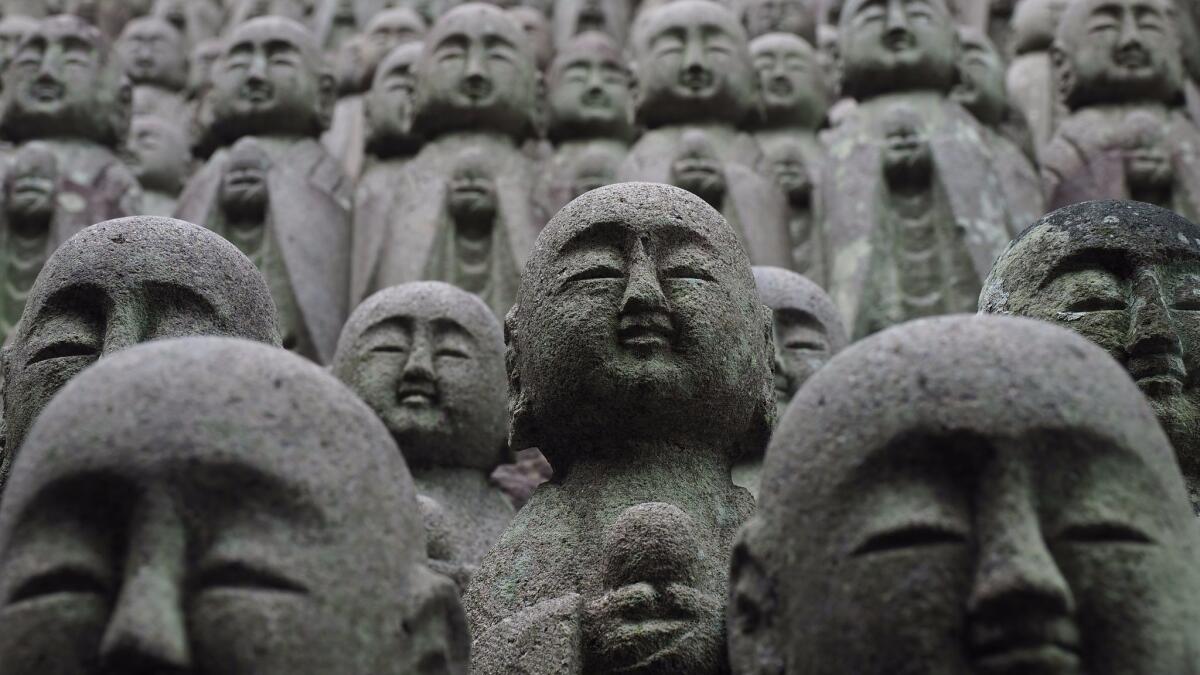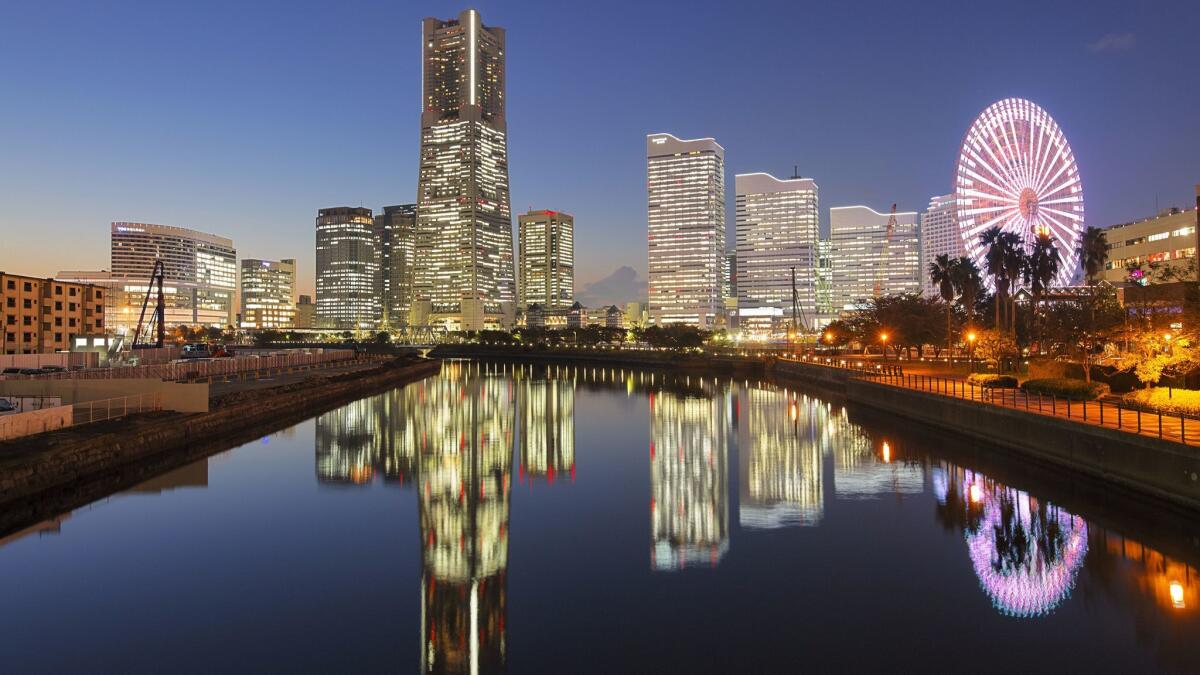Three Tokyo day trips step into Japanese history
- Share via
Reporting from Tokyo — Tokyo is perhaps the world’s most relentlessly modern megalopolis, with bullet trains and robot cafes, cutting-edge architecture, fashions that won’t show up stateside for two years, and fun-seekers cruising around in Mario Kart-style racers.
So it’s hard to fathom that there are easy day trips that can take you as far back as 900 years and remove you from that 21st century head space without letting you forget you’re in Japan.
Three destinations — Kamakura, Nikko and Yokohama — are my favorites for their intrigue and ease of access from the capital.
Kamakura

Why it’s important: Kamakura is so central to Japanese history that an era was named for it. During the Kamakura Period (1185 to 1333) generations of shogun, or military rulers, led a military government here, calling the shots while the more figurehead-like emperors remained in Kyoto hundreds of miles west.
Kamakura is sometimes called “Little Kyoto” for its wealth of Buddhist temples and Shinto shrines. Nowadays it’s a well-off bedroom community southwest of Tokyo and, appropriately for Californians, something of a beach town with a bit of surf culture.
What to see: The Great Buddha of Kamakura is Japan’s second-largest Buddha statue, 37 1/2 feet tall and built of bronze. Constructed in 1252, it has outlasted all the shelters built to house it, the most recent, if you can call it that, after a tsunami in 1498.
Less than 10 minutes away on foot, another Buddhist temple, Hase-dera, may be where I fell in love with Japan when I first lived there in the ’80s. It pays tribute to an imposing statue of Kannon Bodhisattva, the deity of mercy, in a hilltop pavilion with views of Sagami Bay and the Pacific.
I was drawn to the thousands of miniature figurines of the deity Jizo, which line the stairwells and pretty much every other open wall space on the grounds of Hase-dera.

Jizo is patron of the weak, the infirm, travelers, children and others in need of extra care. When I later learned that there’s a tradition of mothers who had lost a child or terminated a pregnancy placing a figurine here in memory of the unborn child, it gave the temple new meaning.
On the north side of town, a walk connects several historic temples between Kamakura Station and Kita-Kamakura Station. You can catch a train back to Tokyo from either station.
Where to eat: Komachi-dori is a pedestrianized shopping street by Kamakura Station, where stalls sell signature snacks such as dove-shaped sablé butter cookies and sweet potato ice cream.
How to get there: It’s about 55 minutes by train from Tokyo Station (on the city’s east side) or Shinjuku Station (on the city’s west side), with stops in between. Shibuya Station also has direct trains to Kamakura. You can buy tickets at the stations; trains run frequently. The best website for scheduling information is www.hyperdia.com. Fare to Kamakura is about $8.
Nikko
Why it’s important: Nikko traces its history as a Buddhist hermitage to the 8th century, but it wasn’t until the 1600s that the site, north of Tokyo, rose to prominence. That’s when it was chosen as the location for the memorial shrine to shogun Tokugawa Ieyasu (1543-1616), widely considered the unifier of Japan.
His capital, a former backwater called Edo (now a megalopolis called Tokyo), was home to a dynastic line that lasted more than 250 years, during which time Japan isolated itself from the rest of the world as only an island nation can.
It’s said that it took 15,000 artisans two years to build the shrine, and much of that grandeur remains today.
What to see: Among the many Buddhist temples and Shinto shrines in the area, the must-visit is the Toshogu Shrine (admission about $12). The complex is composed of several buildings and monuments that take about half a day to see. Even the approach is special, through a giant torii gate, past a 112-foot-tall, five-story pagoda and a stable decorated with the life cycle of monkeys as an allegory for human birth, life and death. It’s said that this is the origin of the clever “hear no evil, see no evil, speak no evil” trio of monkeys representing Buddhist teaching.
Toshogu’s very Instagrammable Yomei-mon (Sunset Gate) was built to dazzle and succeeds, with painted and gilded carvings of flowers, sages and mythical animals. My favorite part of the gate is a section of pillar that was deliberately installed upside-down, without which, it’s said, it would be too perfect and could arouse the anger of the gods.
After Yomei-mon, everything else seems subdued, but it’s worth visiting the main hall with its ceiling paintings of 100 dragons, all different, and a fusuma-e (sliding door) painting of a mythical haku (half giraffe, half dragon), which eats metal — including weapons — and is therefore considered a harbinger of peace. Ieyasu’s tomb is reached up a steep hill behind the shrine.
Where to eat: Restaurants around the shrine area are famous for yuba, thin sheets of tofu. It’s delicate and much better than it sounds when rolled into the consistency of a noodle and served as part of a set meal.
How to get there: The fastest connections to Nikko (just under two hours) depart from Asakusa Station in northeast Tokyo (Tobu Line Limited Express Kinu train) to Shimo-Imaichi and transfer to Tobu-Nikko Station. Tobu Railway sells a combination ticket that includes train and local buses for about $24.
Yokohama

Why it’s important: Two centuries ago Yokohama was a 600-person blip of a fishing village and might have remained so if not for the U.S. Navy.
A flotilla known locally as the Black Ships anchored in the bay in 1853 to persuade Japan to open to foreign trade after centuries of isolation under the Tokugawas.
Yokohama was designated as one of Japan’s first international ports and helped usher it into the modern age with the country’s first newspaper, bank, Western-style hotel and baseball game. Barely 160 years later, it’s a city of 3.7 million, Japan’s second largest after Tokyo, and still proud of its 19th century heritage.
What to see: On a recent trip to Yokohama, I took an urban hike across the city and through history. It started with a climb uphill from the subway station from Tokyo to the Foreigner General Cemetery (open weekends and national holidays March-December) established in 1861 on the west side of town.
A small exhibit of photo reproductions and woodblock prints illustrates the early days of the foreigners’ settlement. From here it’s an easy walk through the woods on the bluff down to Yamashita Park along the bay.
In the city center, the Yokohama Archives of History (closed Mondays; admission about $2) are built around the Japanese bay tree where Commodore Matthew Perry of the U.S. Navy signed the open-port treaty with representatives of the shogun; it’s now a museum about the opening of the port.
Yokohama didn’t get to be Japan’s second-largest city by sitting on its 19th century laurels, as evidenced by the waterside business district that includes Minato Mirai 21 Area (Future Port 21). It has some of Japan’s tallest skyscrapers, a giant Ferris wheel, a contemporary art venue (BankART 1929; admission varies) and even the Cupnoodles Museum (closed Tuesdays; admission about $4.50), where visitors can decorate and custom-build their own cup of noodles.
Where to eat: It wasn’t just Westerners who settled in Yokohama. It’s also home to Japan’s largest Chinatown, filled with a reported 500 restaurants and food shops. It’s one of the few spots I know in Japan where eating on the street is condoned.
How to get there: From Shibuya Station in southwest Tokyo, the Toyoko commuter rail line runs to Yokohama Station and connects, without transfer, to the Minatomirai Line to Motomachi-Chukagai Station (close to the Foreigners’ Cemetery and Chinatown) in about 40 minutes. Fare is about $4.
If you go
THE BEST WAY TO TOKYO
From LAX, JAL, ANA, United, American, Singapore and Delta offer nonstop service to Tokyo, and Korean, JAL, United, Asiana, Delta, Hawaiian, American, Cathay Pacific and Air China offer connecting service (change of planes). Restricted round-trip fares from $617, including taxes and fees.
WHERE TO STAY
Tokyo Station Hotel, 1-9-1 Marunouchi, Chiyoda-ku, Tokyo; 011-81-3-5220-1111. The historic, architecturally significant and recently renovated hotel inside Tokyo Station recalls the glamour of the golden age of rail travel and positions travelers for an easy getaway south or north. Doubles from $451.
Shibuya Excel Hotel Tokyu, 1-12-2 Dogenzaka, Shibuya-ku, Tokyo; 011-81-3-5457-0109. across the street from Shibuya Station, gateway to Yokohama and Kamakura. My favorite rooms offer views of Shibuya Crossing, where lighted signs and video screens recall Times Square on steroids. Doubles from $251.
Hotel Niwa, 1-1-16 Misakicho, Chiyoda-ku, Tokyo; 011-81-3-3293-2228. A bit off the beaten path but intimate and contemporary. Doubles from $215
TO LEARN MORE
Japan National Tourism Organization
More to Read
Sign up for The Wild
We’ll help you find the best places to hike, bike and run, as well as the perfect silent spots for meditation and yoga.
You may occasionally receive promotional content from the Los Angeles Times.






